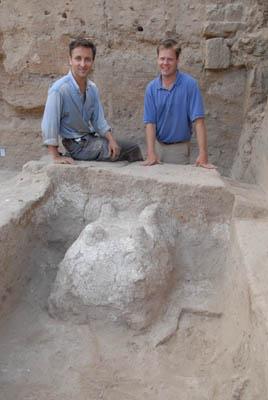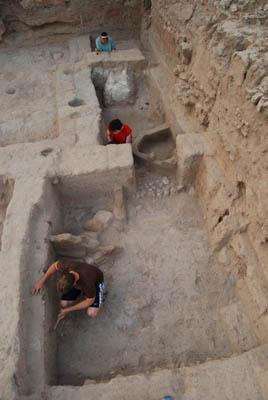Ashkelon Excavations Find New Evidence of Philistine Religion
But purpose of “horned” altar remains a mystery
Source - http://www.biblicalarchaeology.org/daily/biblical-artifacts/artifacts-and-the-bible/ashkelon-excavations-find-new-evidence-of-philistine-religion/
 Archaeologists Daniel Master (right) and Adam Aja (left) of the Ashkelon excavations found this oddly shaped Philistine installation with four rounded projections. Although it may be a type of “horned” altar, its exact function within Philistine religion remains a mystery. Photo courtesy the Leon Levy Expedition to Ashkelon.
Archaeologists Daniel Master (right) and Adam Aja (left) of the Ashkelon excavations found this oddly shaped Philistine installation with four rounded projections. Although it may be a type of “horned” altar, its exact function within Philistine religion remains a mystery. Photo courtesy the Leon Levy Expedition to Ashkelon.
In the summer of 2009, the Ashkelon excavations were working in a typical Philistine domestic structure from about 1200 B.C.E. (roughly contemporaneous with the settlement of the Israelites in adjacent Canaan). In two of the rooms were typical Philistine hearths in the floor. In one of the smaller rooms of the house, however, was a feature the archaeologists did not recognize—a white lime-plastered mound of earth about 2 feet high and around 2.5 feet in diameter. Roughly pyramidal in shape, it had a flattened top. On each of the four corners was a slightly rounded projection. Are they the horns of a horned altar? Was this altar a feature of early Philistine religion?
Lawrence Stager, Daniel Master and Adam Aja, the lead archaeologists of the Ashkelon excavations, didn’t recognize it. It was not like anything they had ever seen. It is of course tempting to call it a Philistine horned altar that played a role in early Philistine religion. At first, the archaeologists considered whether it might be something like an Israelite horned altar, but the Israelite examples are burning installations with a flat top enclosed by a margin to contain the combustion. And there was no evidence that anything had been “burned” on this “horned” altar—or that it was designed for this purpose.

The Ashkelon “horned” altar (visible near top of photo) was found in a typical Philistine domestic structure that may have had a cultic function. It was positioned along the back wall of a room that also contained a small semi-circular bin. Photo courtesy the Leon Levy Expedition to Ashkelon.
The next thought was that perhaps these little bumps on the Ashkelon installation were somehow related to Aegean “horns of consecration” often associated with libations rather than combustion. But these “horns of consecration” are not only quite different but also distant in time from Philistine religion. The suggestion was ultimately rejected.
A Philistine horned altar was also found at nearby Gath (Tell es-Safi) . But it has only two horns and they are nothing like the bumps on the Philistine “horned” altar uncovered by the Ashkelon excavations.
The archaeologists agree that it does appear to be some sort of altar, however, and the room in the house in which it was found may have been a cultic room for the practice of some aspect of early Philistine religion. But it is difficult even for the archaeologists to go further. Maybe our readers can.
Based on Strata, “Altar-ed Theories at Ashkelon,” Biblical Archaeology Review, May/June 2012.